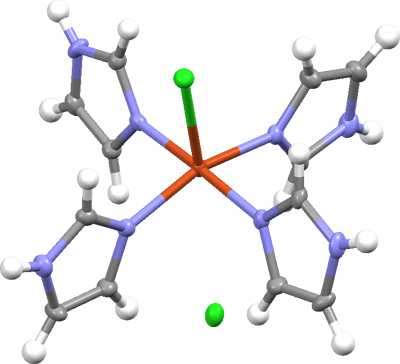Twinning by Pseudo-Merohedry in SHELXL
Note: This tutorial uses older programs: shelxs, shelxl97, and shelxtl XP.
There are several different kinds of twinning in crystallography. This tutorial covers an example of
a fairly common type:
pseudo-merohedric twinning. This type of twinning is possible in crystals where the cell dimensions
(by chance) mimic those of a higher-symmetry crystal system. The example here is
chlorotetrakis-(imidazole)copper(II) chloride, C
12H
16Cl
2CuN
8,
which forms monoclinic crystals with a β angle of almost exactly 90°. It has a cell that is
metrically orthorhombic, even though the underlying symmetry is monoclinic. The structure is
a copper complex with four imidazole ligands, one bound chlorine atom and a free chloride anion for
charge balance. The finished structure looks like this:
Data collection and processing for this crystal were unremarkable, so this tutorial begins after
data scaling and merging. Since the reciprocal lattices of pseudo-merohedric twin components overlap
so well, there may be little if any splitting of reflections. There were no obvious signs in the
diffraction images to suggest that the crystal was not actually orthorhombic. We therefore begin
with just two files: the dataset
k00070.hkl
and an
nreport file
k00070.html.
These files are available for download (click on boldface links) so that you can follow along with
real data.
The tutorial is divided into four parts. The first uses XPREP to find the space group and
to set up the '.ins' file to solve the structure. The second covers initial structure solution by
direct methods with SHELXS. Here it becomes clear that although we can build a recognizable
model, it fails to refine properly. The third part derives the twin law using purely geometric
arguments. The last section describes application of a twin matrix, and subsequent SHELXL
refinement with TWIN and BASF instructions. In the end, refinement is shown to be
quite straightforward, in spite of the twinning.
